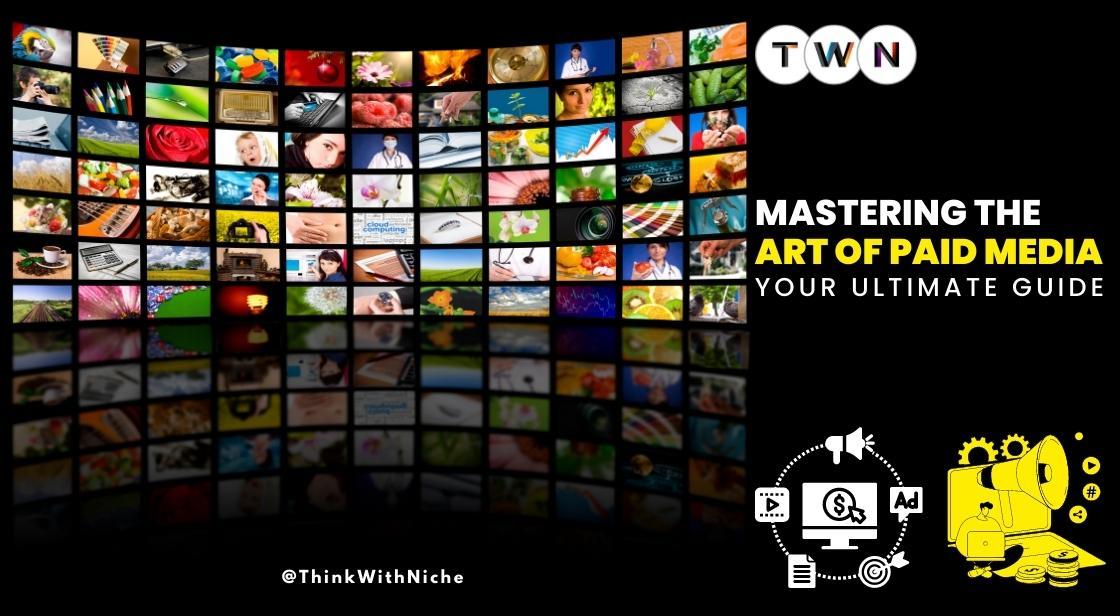Mastering the Art of Paid Media: Your Ultimate Guide

Blog Post
In today's highly competitive digital landscape, businesses and brands are constantly seeking effective ways to reach and engage their target audience. One powerful tool that has emerged as a game-changer in the marketing world is paid media. Paid media refers to the practice of strategically placing ads and content across various digital platforms in exchange for a fee.
Paid media, also known as digital advertising or online advertising, involves strategically placing ads and content across various digital platforms such as search engines, social media networks, websites, and mobile apps in exchange for a fee. This form of advertising allows businesses to amplify their reach, target specific demographics, and drive desired actions from their audience.
paid media has become an essential component of the marketing mix, offering businesses the ability to reach their target audience with precision, scale, and measurable results. By understanding the benefits, strategies, and latest trends in paid media, businesses can leverage this powerful tool to effectively engage their audience, drive desired actions, and achieve their marketing objectives in today's highly competitive digital landscape.
Mastering the Art of Paid Media: Your Ultimate Guide will provide you with all the essential information about paid media, including its benefits, strategies, latest trends, and insights into maximizing its potential for your business.
Paid media is a type of marketing that involves paying for advertising space or time. It can be used to reach a wider audience, generate leads, and drive sales. There are many different types of paid media, each with its own advantages and disadvantages. Paid media can be a very effective way to reach your target audience and achieve your marketing goals.
Mastering the Art of Paid Media: Your Ultimate Guide
The Power of Paid Media in the Digital Age
In today's digital marketing landscape, paid media has become a powerful tool for businesses to enhance their brand visibility, reach their target audience, and drive meaningful engagement. Here, we will delve into the significance of paid media and how it complements other marketing channels, supported by the latest facts and relevant examples.
Paid media plays a crucial role in cutting through the noise and capturing the attention of consumers in a crowded online space. With the increasing number of internet users and the prevalence of social media and search engines, businesses have recognized the need to invest in paid media to stand out and achieve their marketing objectives.
One of the key advantages of paid media is its ability to provide precise targeting capabilities. Platforms like Google Ads, Facebook Ads, and LinkedIn Ads allow businesses to segment their audience based on demographics, interests, behaviors, and more. This targeted approach ensures that advertisements are shown to the most relevant audience, increasing the likelihood of capturing their attention and driving conversions.
For example, a sports apparel brand can utilize paid media on social media platforms to specifically target individuals who are interested in fitness and sports. By reaching this niche audience, the brand can maximize its advertising budget and generate higher-quality leads.
Paid media also complements other marketing channels by amplifying their reach and impact. For instance, businesses can combine their organic social media efforts with paid social media advertising to expand their audience and increase brand awareness. By leveraging paid media alongside content marketing, businesses can ensure that their valuable content reaches a wider audience, ultimately driving traffic to their website or blog.
Furthermore, paid media allows businesses to optimize their campaigns based on real-time data and insights. Platforms provide robust analytics and reporting tools, enabling marketers to measure the performance of their ads, track conversions, and make data-driven decisions. This level of transparency and agility empowers businesses to refine their strategies and allocate their budgets more effectively.
A notable example of the power of paid media is the success of Spotify's personalized ad campaigns. Spotify leverages user data to deliver targeted ads that resonate with individual listeners, enhancing the user experience while generating revenue through paid media placements. By aligning ads with users' listening preferences and behaviors, Spotify has achieved remarkable ad engagement and conversion rates.
The power of paid media in the digital age cannot be underestimated. Its ability to precisely target audiences, complement other marketing channels, and provide data-driven insights is invaluable for businesses seeking to enhance their brand visibility and drive meaningful engagement. By embracing paid media strategies and leveraging the latest tools and platforms, businesses can unlock their full potential and achieve remarkable marketing outcomes.
Types of Paid Media Channels
Paid media encompasses various channels that businesses can utilize to promote their products or services and connect with their target audience. Understanding the different types of paid media channels and their unique advantages is essential for developing an effective marketing strategy. Let's explore some of the prominent paid media channels, including paid search, paid social, display advertising, and more.
1. Paid Search Advertising:
Paid search advertising, often associated with search engine marketing (SEM), allows businesses to display ads prominently on search engine result pages (SERPs). Platforms like Google Ads enable advertisers to bid on specific keywords relevant to their business, ensuring their ads appear when users search for those keywords. The advantages of paid search advertising include:
-
Targeted reach: Advertisers can display their ads to users actively searching for specific keywords, increasing the likelihood of reaching a highly relevant audience.
-
Cost control: Advertisers can set a budget and pay only when users click on their ads (pay-per-click model), making it a cost-effective option.
-
Measurable results: Robust analytics and tracking tools provide insights into ad performance, allowing advertisers to optimize campaigns based on data.
For example, a travel agency bidding on keywords like "best vacation destinations" can leverage paid search advertising to capture users actively searching for travel-related information and drive qualified traffic to their website.
2. Paid Social Media Advertising:
Paid social media advertising involves promoting ads on popular social media platforms such as Facebook, Instagram, Twitter, and LinkedIn. These platforms offer advanced targeting options based on user demographics, interests, behaviors, and more. Key benefits of paid social media advertising include:
-
Audience targeting: Advertisers can narrow down their target audience based on specific criteria, ensuring their ads are shown to relevant users.
-
Visual storytelling: Social media platforms provide opportunities for engaging and visually appealing ad formats, such as image carousels, videos, and interactive elements.
-
Social engagement: Ads on social media platforms often encourage user engagement through likes, shares, comments, and direct interactions.
For instance, an e-commerce business selling fashion accessories can leverage paid social media advertising to reach fashion-conscious users, showcase their products through visually appealing ads, and encourage engagement and conversions.
3. Display Advertising:
Display advertising involves placing visual ads on websites, blogs, or apps within ad spaces. These ads can take various formats, including banners, pop-ups, or native ads. Display advertising offers the following advantages:
-
Wide reach: Display ads can be displayed on a vast network of websites, allowing businesses to reach a broader audience.
-
Brand visibility: Eye-catching visuals and creative designs can enhance brand awareness and capture users' attention.
-
Remarketing opportunities: Display ads can be targeted to users who have previously visited a website or shown interest in specific products or services.
For example, an electronics retailer can utilize display advertising to showcase their latest product offerings on relevant technology websites, reaching users with a demonstrated interest in electronics.
4. Video Advertising:
Video advertising involves displaying video ads on platforms like YouTube, streaming services, and social media. Video ads can be skippable or non-skippable and offer the following benefits:
-
Engaging storytelling: Videos allow businesses to convey their message through compelling visuals, audio, and storytelling techniques.
-
High user engagement: Users often spend significant time watching videos, providing an opportunity for deeper engagement and brand connection.
-
Targeting capabilities: Platforms offer various targeting options, including demographics, interests, and viewing behaviors.
A prime example of video advertising success is the use of YouTube pre-roll ads by beauty brands to showcase makeup tutorials or product demonstrations, effectively engaging their target audience.
Understanding the different types of paid media channels is crucial for businesses to effectively reach and engage their target audience. Paid search, paid social, display advertising, and video advertising each
Also Read: Discover The Best Influencer Marketing Platforms In India-Elevate Your Brand
Creating Successful Paid Media Campaigns
Part 1: Setting Goals and Defining Target Audience
To run successful paid media campaigns, it's essential to start with a clear set of goals and a deep understanding of your target audience. By defining these aspects, you can tailor your campaigns to reach the right people with the right message at the right time. Let's delve into the importance of setting goals and defining your target audience, along with practical strategies to achieve them.
1. Setting Clear Goals:
Establishing specific and measurable goals is crucial for a successful paid media campaign. Consider the following steps:
-
Identify campaign objectives: Determine what you want to achieve with your campaign, whether it's driving website traffic, generating leads, increasing brand awareness, or boosting sales.
-
Define key performance indicators (KPIs): Select metrics that align with your goals, such as click-through rates (CTRs), conversion rates, cost per acquisition (CPA), or return on ad spend (ROAS).
-
Set realistic targets: Based on industry benchmarks and historical data, set achievable targets for your campaign performance.
For instance, if your goal is to increase online sales, your KPIs could be a target CTR of 3%, a conversion rate of 5%, and a ROAS of 500%.
2. Conducting Market Research:
Thorough market research helps you understand your target audience, their needs, preferences, and online behavior. Consider the following steps:
-
Analyze audience demographics: Use tools like Google Analytics, social media insights, or customer surveys to gain insights into your audience's age, gender, location, and interests.
-
Identify pain points and motivations: Understand the challenges your audience faces and what drives their decision-making process.
-
Study competitors: Analyze your competitors' paid media strategies to identify gaps and opportunities in the market.
For example, if you're launching a new line of fitness apparel, market research might reveal that your target audience consists of health-conscious individuals aged 25-40, primarily located in urban areas, and motivated by comfort and sustainability.
3. Leveraging Audience Insights for Effective Targeting:
Once you have a clear understanding of your target audience, leverage the following strategies to optimize your targeting:
-
Segmentation: Divide your audience into smaller segments based on relevant criteria such as demographics, interests, or purchasing behavior. This allows you to create tailored ad campaigns for each segment.
-
Lookalike Audiences: Use platforms like Facebook or Google Ads to target audiences similar to your existing customers. These algorithms identify common characteristics and behaviors to expand your reach.
-
Retargeting: Show ads to users who have previously interacted with your website or shown interest in your products or services. This helps reinforce your brand message and encourages conversions.
For instance, if you're a travel agency targeting adventure-seeking millennials, you could create separate ad campaigns for segments such as "outdoor enthusiasts," "budget travelers," or "solo adventurers."
Setting clear goals and defining your target audience are fundamental steps in creating successful paid media campaigns. By clearly defining your objectives, conducting thorough market research, and leveraging audience insights for effective targeting, you can optimize your campaigns to reach the right audience with compelling messages. Remember, ongoing monitoring and optimization are key to maximizing the impact of your paid media efforts.
Creating Successful Paid Media Campaigns
Part 2: Crafting Compelling Advertisements
Once you have set clear goals and defined your target audience, the next crucial step in creating successful paid media campaigns is crafting compelling advertisements. The art of creating persuasive ad copy and visuals can significantly impact the effectiveness of your campaigns. Let's dive into the key elements and strategies for crafting compelling ads.
1. Captivating Ad Copy:
The ad copy plays a vital role in grabbing users' attention and conveying your message effectively. Consider the following strategies:
-
Concise and compelling headlines: Use attention-grabbing headlines that highlight the unique value proposition of your product or service. Keep it concise and impactful.
-
Clear and concise messaging: Clearly communicate the benefits and solutions your offering provides. Focus on the audience's pain points and address them directly.
-
Use persuasive language: Employ persuasive language that appeals to the emotions and desires of your target audience. Highlight key features, discounts, or limited-time offers to create a sense of urgency.
For example, a headline like "Unlock Your Full Potential with Our Advanced Fitness Program" immediately conveys the benefits and appeals to individuals seeking personal growth and fitness.
2. Engaging Visuals:
Compelling visuals play a crucial role in capturing users' attention and conveying your brand message effectively. Consider the following strategies:
-
High-quality images or videos: Use visually appealing and high-resolution visuals that showcase your product or service in the best light. Avoid generic stock photos and opt for authentic and relatable visuals.
-
Visual storytelling: Use visuals to tell a story that resonates with your target audience. Show the desired outcomes or lifestyle associated with your offering.
-
Consistent branding: Ensure that your visuals align with your brand identity, including colors, fonts, and overall aesthetics. Consistency helps create brand recognition and trust.
For example, an e-commerce ad for a fashion brand can showcase high-quality images of models wearing their latest collection, effectively conveying the style and quality of the products.
3. Compelling Calls-to-Action (CTAs):
A strong call-to-action is essential for driving user engagement and conversions. Consider the following strategies:
-
Clear and actionable CTAs: Use concise and straightforward language to encourage users to take the desired action. Use verbs and words that create a sense of urgency or exclusivity.
-
Placement and visibility: Position your CTA prominently and ensure it stands out from the rest of the ad. Use contrasting colors and appropriate sizing to draw attention to the CTA button.
-
A/B testing: Experiment with different CTAs to determine which ones resonate best with your target audience. Test variations in wording, color, and placement to optimize conversion rates.
For example, a CTA like "Shop Now and Enjoy 20% Off Your First Order" provides a clear incentive and encourages immediate action.
Crafting compelling advertisements involves the art of creating persuasive ad copy, engaging visuals, and compelling calls-to-action. By focusing on concise and compelling messaging, captivating visuals, and strong CTAs, you can create ads that resonate with your target audience, drive engagement, and ultimately achieve your campaign goals. Remember to continually test and optimize your ads based on user feedback and data to maximize their impact and effectiveness.
Keyword Research for Paid Search Campaigns
Keyword research is a critical step in setting up successful paid search campaigns. It involves identifying and selecting the most relevant and effective keywords that align with your business goals and target audience. Here are the key steps to conducting keyword research:
-
Identify campaign objectives: Define your campaign objectives, such as increasing brand awareness, driving conversions, or boosting website traffic. This will help you focus on keywords that align with your goals.
-
Brainstorm seed keywords: Begin by brainstorming a list of seed keywords that are relevant to your business, products, or services. These are the starting point for your keyword research.
-
Use keyword research tools: Utilize keyword research tools like Google Keyword Planner, SEMrush, or Moz Keyword Explorer to expand your keyword list. These tools provide insights into search volume, competition, and related keywords.
-
Analyze competitor keywords: Study your competitors' paid search campaigns and identify the keywords they are targeting. This can give you valuable insights and help you discover new keyword opportunities.
-
Consider long-tail keywords: Long-tail keywords are more specific and have lower search volume but often indicate higher user intent and conversion potential. Include long-tail keywords in your research to capture niche audiences.
-
Refine keyword list: Evaluate your keyword list based on relevance, search volume, competition, and user intent. Remove irrelevant or low-performing keywords and prioritize those that have higher potential for success.
-
Group keywords into themes: Group keywords into relevant themes or ad groups to create targeted and focused campaigns. This allows for more precise ad messaging and higher ad relevance.
Optimization Techniques for Paid Search Ads
Once you have set up your paid search campaigns, it's essential to continuously optimize your ads to improve their performance and increase click-through rates. Here are some optimization techniques to consider:
-
Ad Copy Optimization: Create compelling and relevant ad copy that speaks to your target audience. Incorporate keywords into the ad headline, description, and display URL to enhance ad relevance and attract clicks.
-
Ad Extensions: Take advantage of ad extensions like sitelinks, callouts, and structured snippets to provide additional information and improve ad visibility. Ad extensions can enhance your ad's appearance and increase the chances of attracting clicks.
-
A/B Testing: Conduct A/B tests to compare different ad variations, such as headlines, descriptions, and calls-to-action. Test different elements to identify the most effective combinations and refine your ads accordingly.
-
Landing Page Optimization: Ensure that your landing pages are optimized for a seamless user experience. Align the messaging of your ads with the landing page content, make the page visually appealing, and ensure fast load times to improve conversion rates.
-
Negative Keywords: Regularly review search terms and add negative keywords to prevent your ads from showing for irrelevant searches. This helps optimize your budget and ensures that your ads are reaching the most relevant audience.
-
Bid Management: Monitor and adjust your bids based on performance data. Allocate more budget to high-performing keywords and consider adjusting bids for different devices, locations, or times of day to maximize ROI.
-
Tracking and Analytics: Implement conversion tracking and analyze performance metrics like click-through rates, conversion rates, and cost-per-conversion. Use these insights to make data-driven decisions and refine your campaigns.
By conducting thorough keyword research and implementing optimization techniques, businesses can create highly targeted and effective paid search campaigns.
Conclusion:
Paid media has become an integral part of successful digital marketing strategies. By harnessing the power of paid media channels, businesses can effectively reach and engage their target audience, drive conversions, and maximize their return on investment. With a comprehensive understanding of paid media, its strategies, and the latest trends, you are equipped to leverage its potential and propel your business forward in the ever-evolving digital landscape.
You May Like
EDITOR’S CHOICE












